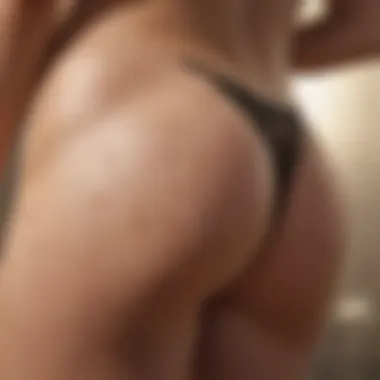Eliminate Butt Acne Fast: A Complete Guide


Intro
Butt acne is a common issue, yet it often remains under-discussed. For many, it is an embarrassing condition that can lead to discomfort and self-consciousness. Understanding how to prevent and treat this condition is crucial for those affected. This guide offers insights into the various causes of butt acne, treatment options, and preventative measures, equipping readers with useful knowledge for maintaining clearer skin.
Causes of Butt Acne
Butt acne can arise due to various factors. Some of the most common causes include:
- Friction: Tight clothing can cause friction, leading to follicle irritation.
- Sweat and Oil Build-up: Sweat combined with oils can clog pores.
- Hormonal Changes: Fluctuations in hormones can increase oil production, exacerbating the condition.
- Bacterial Growth: The presence of bacteria can aggravate existing acne.
These factors often compound, making butt acne a persistent issue for many. Understanding these causes allows for targeted intervention.
Types of Butt Acne
Not all butt acne is the same. Recognizing the type you have can guide treatment. Common types include:
- Pustules: These are small, pus-filled bumps that can be red and painful.
- Cysts: These are larger, fluid-filled lumps that can be especially uncomfortable.
- Papules: These are small, red bumps without pus, often a result of inflammation.
Identifying the type of acne is essential when selecting treatments.
Preventative Measures
Prevention plays a key role in managing butt acne. Consider these strategies:
- Wear Loose Clothing: Opt for breathable fabrics to minimize friction.
- Maintain Hygiene: Shower regularly, especially after sweating.
- Use Non-Comedogenic Products: Ensure that lotions and creams do not block your pores.
- Exfoliate: Regular exfoliation helps remove dead skin cells and prevents pore blockage.
Implementing these measures can significantly reduce the chances of developing butt acne.
Treatment Options
When butt acne occurs, various treatment options are available. These range from topical solutions to lifestyle changes:
- Topical Creams: Products containing salicylic acid or benzoyl peroxide can be effective.
- Over-the-Counter Treatments: Many formulations target acne specifically.
- Lifestyle Adjustments: Staying hydrated, eating a balanced diet, and managing stress may also help.
Treatments can vary in effectiveness based on skin type and severity of acne, making it vital to choose wisely.
Importance of Skin Hygiene
Maintaining proper skin hygiene cannot be overstated. Regular cleaning removes bacteria and oil build-up, reducing the risk of further outbreaks. Simple routines, like including gentle scrubbing and moisturizing in your daily practice, can lead to improvements.
When to Seek Professional Help
In some cases, professional guidance may be necessary. If the acne is persistent, painful, or showing no signs of improvement after home treatments, consulting a dermatologist is recommended. Professionals can offer tailored advice and prescription treatments that may be more effective.
"Early intervention can make a significant difference in managing skin conditions effectively."
Finale
Understanding the causes, types, and treatments for butt acne is crucial. By applying preventative measures, maintaining proper hygiene, and seeking professional assistance when necessary, you can manage this condition effectively and work towards clearer skin. This guide aims to empower you with the knowledge needed for a proactive approach to butt acne.
Understanding Butt Acne
Understanding butt acne is crucial for anyone seeking to address this particular skin issue effectively. This article will outline the nature of butt acne, its symptoms, and the common causes behind it. Grasping these fundamentals can help not only in identifying the problem but also in taking informed actions toward resolution.
Definition and Symptoms
Butt acne refers to the occurrence of pimples, bumps, or inflammation on the skin of the buttocks area. It can appear in various forms, notably folliculitis and cystic acne. Symptoms often include redness, swelling, and tenderness in the affected areas. Some may experience itching or burning sensations. Recognizing these symptoms early allows for prompt treatment, reducing the risk of further skin issues.


Common Causes
Understanding the causes of butt acne can facilitate effective prevention and treatment.
Hormonal changes
Hormonal changes can significantly impact skin health. Fluctuations during puberty, menstrual cycles, or hormonal treatments can lead to increased oil production. This overproduction can create an ideal environment for acne to thrive. Addressing hormonal imbalances through lifestyle changes or medical intervention can be beneficial in reducing instances of butt acne.
Pores clogging
Pores can become clogged due to various factors such as excess oil, dead skin cells, or external pollutants. This clogging is a key contributor to acne development. It limits air flow and traps bacteria, leading to inflammation. Regular exfoliating can help prevent clogging and reduce the likelihood of acne formation. It is a straightforward yet effective strategy for maintaining clear skin.
Friction and sweating
Friction from tight clothing or prolonged sitting can exacerbate skin irritation. Combined with sweating, it creates a conducive environment for butt acne to form. Moisture combined with friction can lead to folliculitis, where hair follicles become inflamed. Choosing breathable fabrics and allowing for proper air circulation can mitigate this risk. Staying vigilant about clothing choices and activity levels is essential to keep butt acne at bay.
Types of Butt Acne
Understanding the types of butt acne is crucial for effective treatment and management. Each type of acne presents unique characteristics and requires distinct approaches for successful elimination. Recognizing these differences can help tailor treatment strategies, minimizing discomfort and promoting quicker recovery. By identifying the specific type of butt acne you are experiencing, you can make informed choices regarding treatments and preventatives.
Folliculitis
Folliculitis is a common and often misunderstood condition. This form of acne occurs when hair follicles become inflamed. It can be triggered by bacteria, yeast, or irritation caused by excessive friction. In butt acne cases, shaving or wearing tight clothing can contribute to this irritation. Symptoms may include red, inflamed bumps resembling acne, sometimes filled with pus.
To manage folliculitis effectively, consider the following strategies:
- Maintain proper hygiene to keep the affected area clean.
- Apply warm compresses to soothe irritation.
- Use antibacterial cleansers to reduce bacterial growth.
- If necessary, seek topical antibiotics from a healthcare provider.
Cystic Acne
Cystic acne is more severe and can be particularly painful and bothersome. It develops deep within the skin and surrounds the hair follicle. This type of acne occurs when oil and dead skin cells clog the follicle, leading to inflammation. Cystic acne appears as larger, deeper nodules or cysts that can be tender to touch, often associated with considerable discomfort and potential scarring.
Treating cystic acne involves different methods than those used for folliculitis. Recommended approaches include:
- Using stronger topical treatments, such as benzoyl peroxide and salicylic acid.
- Considering systemic medications like antibiotics to reduce inflammation.
- Exploring options like corticosteroid injections, which can provide quick relief from painful cysts.
- Always consult a dermatologist for persistent cases or before starting any new treatments.
Conclusively, recognizing the types of butt acne aids in selecting the most effective treatment strategies. By understanding the nuances between folliculitis and cystic acne, individuals can navigate their skincare approach more effectively.
Preventative Measures
Preventative measures play a crucial role in reducing the occurrence of butt acne. Taking proactive steps can significantly enhance overall skin health and prevent the development of new blemishes. By focusing on proper hygiene practices and making mindful clothing choices, individuals can directly address factors contributing to butt acne. Preventative measures not only help in maintaining clarity of the skin but also contribute to overall confidence and comfort.
Proper Hygiene Practices
Regular washing
Regular washing is fundamental in managing skin conditions like butt acne. Keeping the area clean removes excess oil, dirt, and bacteria that can lead to clogged pores. Many people may underestimate the impact of hygiene, yet it can be a simple yet powerful first step. This cleanliness is a beneficial choice within this article's context as it helps to prevent the buildup of sebum.
One unique aspect of regular washing is the ability to utilize various cleansing products specialized for body acne. Incorporating antifungal or antibacterial cleansers can also enhance its effectiveness. However, over-washing the skin can strip it of natural oils, which is a disadvantage since this might lead to irritation. Therefore, it is important to find a balance that promotes cleanliness without compromising skin barrier health.
Exfoliation techniques
Exfoliation techniques are another essential aspect of butt acne prevention. Regularly sloughing off dead skin cells helps to avoid clogged pores, a common issue leading to acne. This method is popular due to its dual function of keeping skin smooth while preventing acne outbreaks. One unique feature of exfoliation is that it can be performed with physical scrubs or chemical exfoliants, each offering different benefits.
Physical exfoliants may provide immediate smoothness, while chemical exfoliants, like alpha and beta hydroxy acids, target deeper layers for long-term improvements. However, over-exfoliation can result in increased sensitivity or inflammation, which could worsen the skin condition. Care should be taken to exfoliate gently and not too frequently to maintain a healthy skin environment.
Clothing Choices
Avoiding tight clothing


Avoiding tight clothing is an important factor in preventing butt acne. Tight garments can trap moisture and heat, creating a breeding ground for bacteria. Choosing looser-fitting designs allows for better airflow and reduces friction, which is advantageous for those with sensitive skin. This approach is a smart choice for readers focused on preventing acne through practical clothing adjustments.
The unique feature of avoiding tight clothing is the environmental change it creates for the skin. With fewer restrictions, skin can breathe and recover more effectively. A disadvantage may be that some may favor form-fitting styles for fashion reasons. Nonetheless, prioritizing skin health encourages smart wardrobe choices that support both aesthetics and wellbeing.
Choosing breathable fabrics
Choosing breathable fabrics can further assist in minimizing butt acne. Materials such as cotton, linen, and moisture-wicking fabrics allow sweat to evaporate, keeping the skin dry and reducing the likelihood of breakouts. This practice is beneficial because it enhances comfort during activities, such as exercising, while maintaining skin clarity.
An important characteristic of breathable fabrics is that they provide a cooling effect for the skin. In turn, this reduces perspiration build-up, which can obstruct pores. However, it is important to be cautious with fabric blends that claim to be breathable but contain synthetic fibers that may still trap moisture. Thus, carefully selecting high-quality fabrics is vital for effective prevention.
Topical Treatments
Topical treatments play an essential role in the management and elimination of butt acne. Having the right treatment can significantly affect the speed and effectiveness of clearing the skin. Various options available help target the acne directly on the skin, making it possible to address the issue more quickly than through systemic solutions, such as oral medications. These treatments often come in the form of creams, gels, or liquids that can be easily applied to the affected area.
Over-the-counter Solutions
Over-the-counter (OTC) solutions are commonly the first-line treatment for many individuals dealing with butt acne. They are readily accessible and convenient for self-treatment. Among these solutions, benzoyl peroxide and salicylic acid are widely recognized and effective.
Benzoyl peroxide
Benzoyl peroxide is a powerful ingredient known for its antibacterial properties. It effectively reduces the presence of acne-causing bacteria on the skin. This product works by penetrating the skin and oxidizing the bacteria, which helps to eliminate them.
One of the key characteristics of benzoyl peroxide is its ability to exfoliate the skin, which helps prevent clogged pores. This makes it a popular choice among individuals seeking quick results against butt acne.
The unique feature of benzoyl peroxide lies in its high potency. However, potential disadvantages include skin irritation and dryness, especially for those with sensitive skin. It is advisable to start with lower concentrations and gradually increase usage as tolerated.
Salicylic acid
Salicylic acid is another common OTC treatment. It is a beta hydroxy acid (BHA) that not only helps in unclogging pores but also reduces inflammation. Salicylic acid penetrates the skin lightly, exfoliating dead skin cells and preventing future breakouts.
The key characteristic of salicylic acid is its ability to target whiteheads and blackheads effectively while also being anti-inflammatory. This makes it a favorable option in treating butt acne.
One unique feature of salicylic acid is its ability to work well in combination with other treatments, enhancing their effectiveness. However, it can also cause dryness or flakiness if overused.
Natural Remedies
Natural remedies offer a gentler approach to treating butt acne, often appealing to individuals looking for alternatives to OTC products. Two popular options are tea tree oil and apple cider vinegar.
Tea tree oil
Tea tree oil is renowned for its natural antibacterial and anti-inflammatory properties. In terms of butt acne, it helps combat bacteria that lead to breakouts. Its potency lies in its composition, which includes compounds that can effectively reduce the severity of acne lesions.
A key characteristic of tea tree oil is that it is well-tolerated by most skin types, making it a beneficial option for individuals seeking natural remedies.
However, tea tree oil can cause irritation in some individuals, especially when used in high concentrations. It is often recommended to dilute it with a carrier oil before application to minimize any adverse effects.
Apple cider vinegar
Apple cider vinegar is praised for its versatility in treating various skin conditions, including butt acne. It possesses acetic acid, which has antimicrobial properties. This can help to balance skin pH and reduce the presence of acne bacteria.
A notable characteristic of apple cider vinegar is its availability and affordability as a home remedy. This makes it widely accessible for those who prefer DIY solutions.
On the downside, apple cider vinegar can be too harsh for some skin types, leading to possible irritation. Diluting it before application is highly advisable to avoid adverse reactions.
Lifestyle Adjustments
Lifestyle adjustments play a pivotal role in addressing butt acne effectively. It is not purely about topical treatments; one's daily habits greatly influence skin health. By focusing on what you eat and how you manage stress, you can create a holistic approach toward clearing acne. These changes are often simple yet impactful, offering benefits beyond just combating butt acne.
Dietary Considerations


Reducing sugar intake
Reducing sugar intake is an important aspect of diet when trying to eliminate butt acne. High sugar consumption can increase insulin levels, which may lead to inflamed skin and contribute to acne. Too much sugar often results in hormonal spikes that can trigger breakouts. This makes reducing sugar a beneficial choice when targeting skin issues.
The key characteristic of reducing sugar is its ability to stabilize blood sugar levels. Less sugar can lead to a decrease in inflammation and oil production on the skin. A consistent low sugar diet can result in clearer skin due to reduced risk of clogged pores. However, this adjustment might require discipline, as sugar is often hidden in various foods.
Increasing hydration
Increasing hydration is another critical factor to consider. Proper hydration aids in digestion, detoxifies the skin, and helps maintain moisture balance. When the body is well-hydrated, it can effectively eliminate waste products that might contribute to skin impurity.
The uniqueness of hydration lies in its simplicity; all one needs to do is drink sufficient water throughout the day. It is generally recommended to consume at least eight glasses, but this can vary based on individual needs. Hydration can lead to softer skin and potentially fewer breakouts. However, relying solely on water without addressing other aspects of the diet may not yield immediate improvements.
Stress Management
Meditation techniques
Meditation techniques are effective for managing stress, which is known to exacerbate acne conditions. When you are stressed, the body produces more cortisol, a hormone that can increase oil production and cause inflammation. Practicing meditation can help calm the mind and reduce stress levels.
The significant characteristic of meditation is its ability to promote mindfulness and presence in the moment. Engaging in regular meditation creates a habit of mental clarity. As stress decreases, so does the likelihood of acne flare-ups. However, acquiring a meditation routine requires commitment, which some may find challenging.
Regular exercise
Regular exercise is another essential lifestyle adjustment. Exercise improves blood circulation, which helps nourish skin cells. It also reduces stress, leading to lower cortisol levels. Through consistent physical activity, individuals may notice an improvement in their skin's clarity.
One attractive feature of exercise is its versatility; it can be enjoyed in various forms like running, yoga, or sports. This makes it a more accessible option for many. Nevertheless, it is crucial to shower and practice good hygiene post-exercise to avoid sweat build-up, which can clog pores and worsen acne.
Ultimately, the combination of dietary adjustments and stress management can significantly impact the health of your skin. Taking these steps can lead to improved overall well-being and a clearer complexion.
When to Seek Professional Help
Navigating the world of skincare, particularly when dealing with concerns like butt acne, can be daunting. While many treatments and preventative measures are accessible, knowing when to reach out to a professional is crucial. Understanding the signs that indicate professional guidance can save time and lead to better results.
Identifying Severe Acne
Determining the severity of your acne is the first step toward knowing if you need professional assistance. Severe acne may be characterized by:
- Persistent lesions: If you notice that despite trying various over-the-counter treatments, the acne is not clearing up, it could indicate a deeper issue.
- Pain and inflammation: Symptoms such as intense pain or significant swelling around the bumps can signify that the condition requires medical attention.
- Cysts and nodules: The presence of large, painful cystic formations or nodules under the skin can lead to scarring if not treated promptly.
- Spread or increase: If you observe that the acne is spreading or worsening over a short period, it may be time to seek professional help.
Consulting a Dermatologist
A dermatologist possesses the expertise needed to evaluate your skin condition accurately. Consulting a dermatologist can be beneficial when:
- Self-treatment fails: If your attempts at home remedies or over-the-counter products have not yielded results after a reasonable period, professional insight is valuable.
- Underlying issues are suspected: Sometimes, butt acne can be a symptom of an underlying hormonal imbalance or other skin condition. A dermatologist can conduct thorough assessments to identify such issues.
- Personalized treatment plans are needed: Every individual’s skin is unique. A dermatologist can recommend tailored treatments, which could include prescription medications, specific topical treatments, or advanced procedures.
- Navigating emotional distress: If butt acne affects your emotional well-being or confidence, speaking to a dermatologist can also provide guidance and support.
Seeking timely professional help can prevent long-term damage and facilitate a clear treatment strategy tailored specifically to your needs.
In summary, while knowledge of at-home treatments is essential, it is equally important to recognize when professional intervention is necessary. Proactive engagement with experts can lead you to clearer skin and better overall confidence.
Epilogue
Addressing the subject of butt acne is essential not only for aesthetic reasons but also for overall skin health. This article serves as a valuable resource for understanding the multifaceted nature of this condition. Recognizing the symptoms and common causes allows individuals to take informed steps toward prevention and treatment. The consequences of neglect can lead to severe cases, which may require professional intervention.
The prevention tips outlined here emphasize the significance of proper skin hygiene and suitable clothing choices. These are crucial in minimizing flare-ups and ensuring that the skin remains clear and healthy. Moreover, adopting specific lifestyle adjustments enhances not only skin appearance but overall well-being.
When it comes to treatments, options range from over-the-counter solutions to natural remedies. Understanding what works best for your skin type can expedite the healing process. It is also vital to consult a dermatologist if conditions worsen or do not improve with basic treatments.
Having a well-rounded perspective on butt acne enables one to manage their skin effectively. By maintaining proper hygiene, being mindful of clothing, making necessary lifestyle changes, and seeking professional help when needed, individuals can achieve clearer skin. This conclusion synthesizes the core elements discussed throughout the guide, reinforcing the idea that proactive care is key to effectively eliminate butt acne.
Summary of Effective Strategies
- Maintain proper hygiene: Regularly wash the affected area with gentle cleansers.
- Consider exfoliation: Use safe exfoliation techniques to help prevent blocked pores.
- Choose the right clothing: Wear breathable fabrics to reduce friction and sweat accumulation.
- Explore treatment options: Look into benzoyl peroxide and salicylic acid for topical treatments.
- Utilize natural remedies: Try tea tree oil and apple cider vinegar as alternative solutions.
- Stay hydrated: Drink plenty of water to support overall skin health.
- Manage stress: Incorporate meditation or exercise into your routine to alleviate stress factors that affect skin condition.
Remember, consistency in these strategies is crucial for effective acne management.
By combining these practices, individuals can significantly reduce the occurrence of butt acne while enjoying a boost in confidence and comfort.















